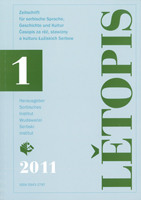Nabožina a narodnosć pola katolskich Serbow w Hornjej Łužicy
Religion and Nationality amongst the Catholic Sorbs of Upper Lusatia
Author(s): Dietrich Scholze-ŠołtaSubject(s): Cultural history
Published by: Domowina-Verlag GmbH / Ludowe nakładnistwo Domowina
Keywords: religion; nationality; reformation; protestant; identity; ethnic orign; catholic; Sorbs
Summary/Abstract: By the middle of the 16th Century the Reformation had spread to large areas of central Germany, including the whole of Lower Lusatia and the north-eastern part of Upper Lusatia (around 90% of the Sorbs). The constitution specific to the nominal margraviate of Upper Lusatia (“corporate republic”) allowed the old and new religions to co-exist. A permanent group of eight Catholic parishes remained between Bautzen, Kamenz and Hoyerswerda, which had an almost exclusively (Upper) Sorbian population. The Sorbian Catholics differ to this day from the Protestant, German area surrounding them as a result of a “double barrier” of religion and nationality. They were able to consolidate their own identity and their own “milieu”, and as a result they were – from about 1800, the beginning of the modern period - largely spared assimilation. The situation for the Catholic Sorbs is very different from that of the Protestant Sorbs in that for the approximately 15-20,000 Catholics faith and (Sorbian) ethnic origin form a whole; their traditional territory is regarded today as the core Sorbian area.
- Issue Year: 2011
- Issue No: 1
- Page Range: 44-50
- Page Count: 7
- Language: Sorbian languages
- Content File-PDF

